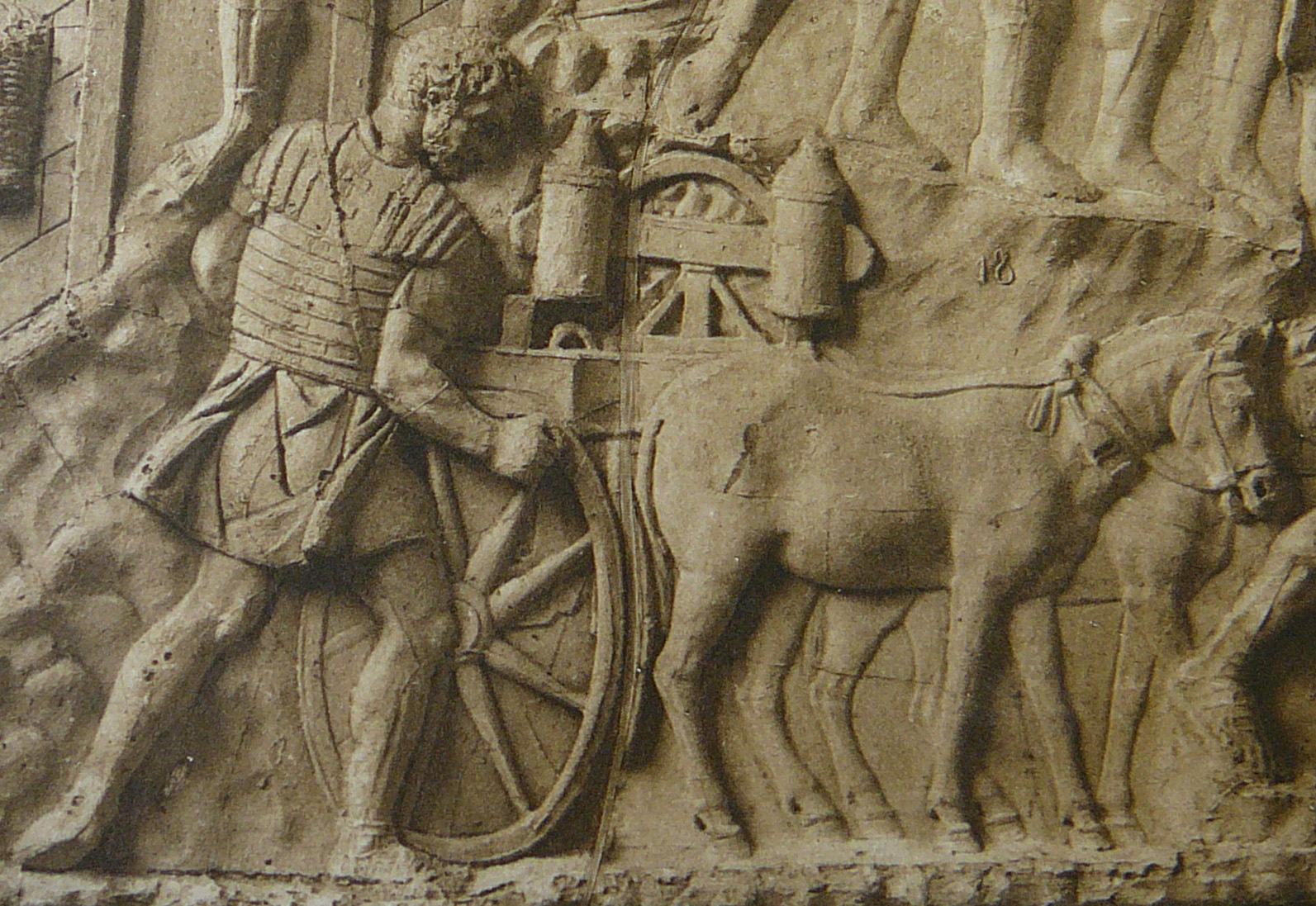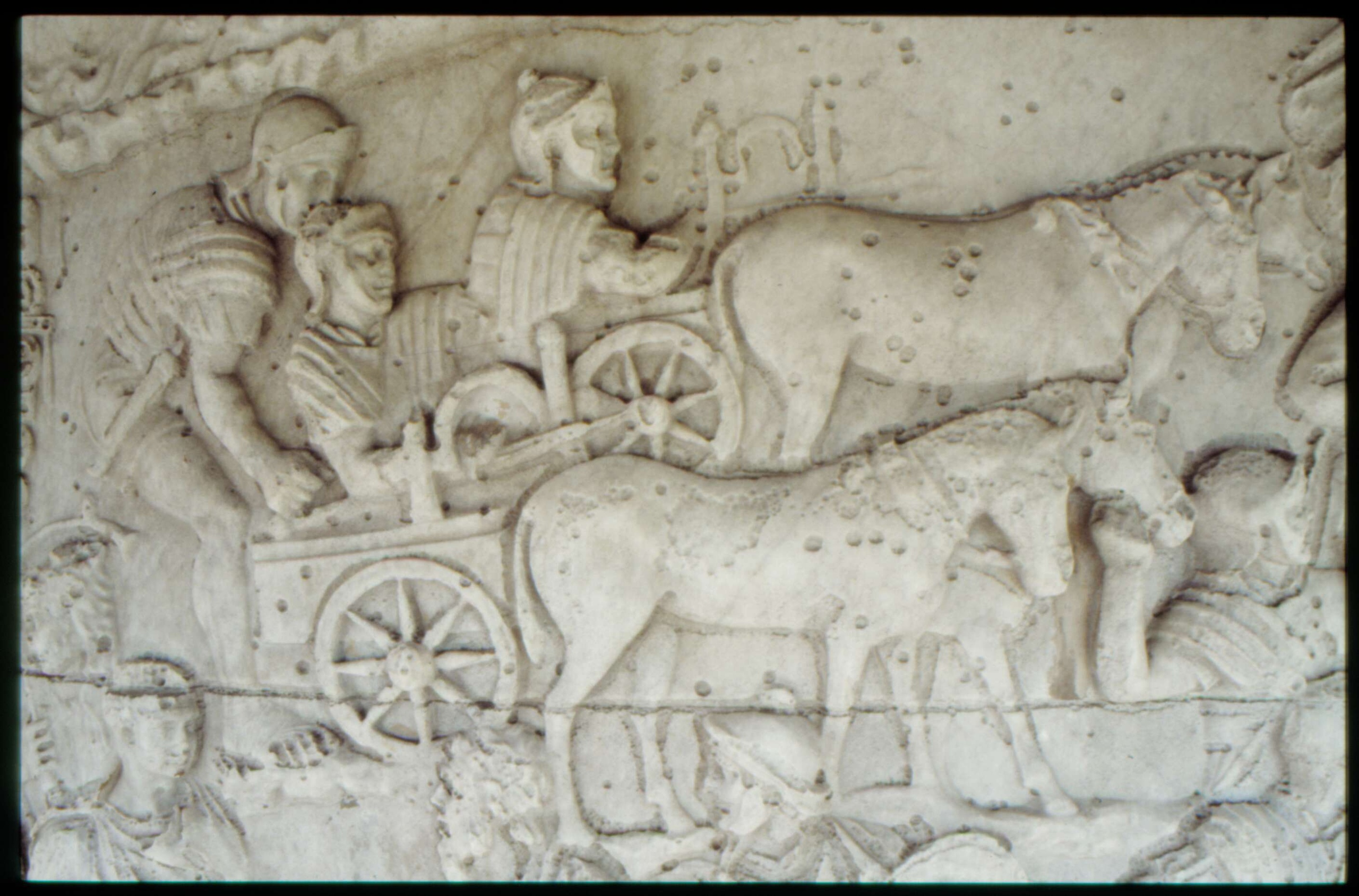Siege Engines
Siege engines in antiquity were a type of military technology first used in ancient times and later in the Middle Ages. These machines typically converted human muscular effort into the energy needed to propel projectiles. This conversion was usually achieved by gradually storing potential energy (using elastic elements or counterweights) and then releasing it suddenly. The primary source of energy was the bending or twisting of materials.
The ancestors of siege engines were the sling and the bow.
 Image of a siege engine on Trajan's Column. 2nd century AD.
Image of a siege engine on Trajan's Column. 2nd century AD.
List of Siege Engines
Gastraphetes: Enlarged bows (tension machines). Depending on their design, they could launch both stones and arrows. All gastraphetes are, by definition, double-armed machines. This classification includes all types of frame-mounted bows, such as the Greek oxybeles.
Euthytones: Double-armed arrow-launchers that use bundles of sinews or hair (torsion machines). Roman scorpions fall under this category.
Palintones: Double-armed stone-throwers that use bundles of sinews or hair (torsion machines). The subclass polybolos—light automatic arrow and stone-throwers, which operated with external energy provided by the crew’s muscle power—also belongs to the double-armed torsion machines.
Onagers (monancorae): Single-armed stone-throwers that use bundles of sinews or hair (torsion machines) and the principle of the sling to enhance the throw.
Tensioned Springalds: Single-armed arrow-launchers that use the energy of a springy board.
Einarmes: Single-armed stone-throwers that also use the energy of a springy board or multiple boards.
Trebuchets: Single-armed stone-throwers that use counterweights (gravitational or "non-deformational machines with counterweights") and the principle of the sling. This type of machine appeared in the Middle Ages and was not used in antiquity.
Perriers: Machines that use the muscle power of the crew (non-deformational machines without counterweights).
The terms "ballista," "catapult," and "scorpion," which often cause confusion in scholarly literature, have the following meanings:
Ballista: The Roman name for a double-armed palinton, usually not very large; typical legionary ballistae threw stones 15-18 cm in diameter. Some non-typical ones could function as euthytones, i.e., large-caliber arrow-launchers that fired not just arrows, but massive stakes or even logs.
Catapult: A Greek term used to refer to any siege engine. However, in a narrower sense, it usually refers to double-armed torsion arrow-launchers, but it’s not a strict, legally fixed use of the word "catapult." During the Roman period, "catapult" could refer to anything: a ballista, an onager, or even a scorpion.
Scorpion: A light Roman euthyton, widely used not only during sieges but also as naval and field artillery.
 Image of a siege engine on Trajan's Column. 2nd century AD.
Image of a siege engine on Trajan's Column. 2nd century AD.
Classification
In Greece and Rome, there were many types of siege engines. Therefore, their classification options are quite extensive. According to their operating principle:
Tension Machines: Using the energy of elastic tension (deformation) of boards, plates, springs, rods, and composite constructions made from them.
Single-Armed:
- Tension Springald (rutta, sometimes incorrectly called bricole, scorpion)
Double-Armed:
- Arcballista (frame-mounted crossbow, toxoballista, Greek oxybeles)
- Einarm (tension onager)
- Shaabhl ("crossbow onager", onager powered by a massive bow fixed to a rebound frame, sometimes mistakenly called "mangonel").
- Torsion Machines: Using the energy of twisted bundles of sinews, ropes, or animal and human hair.
Single-Armed:
- Onager (Greek monancora)
Double-Armed:
- Ballistae
- Caroballista (chiroballista)
- Manuballista
Siege engines of both torsion and tension types are often collectively referred to as neuroballistic.
By type of projectile used:
- Stone-Throwers: These could use stone or metal shot, pots and barrels filled with incendiary mixtures, and sometimes more exotic munitions, such as severed human heads, beehives, corpses of diseased animals, or chunks of rotting meat.
- Arrow-Launchers: Fired arrows, spears, javelins, bolts, and other elongated projectiles.
- Combined Weapons
By function:
- Field Artillery: Mobile weapons used on battlefields with minimal fortifications. These were usually equipped with wheeled carriages or runners, or they were lightweight and compact enough to be easily transported by a small crew.
- Siege Weapons: Heavy, stationary weapons, typically with high power and long range, used to destroy fortifications, target enemy personnel, and hurl harmful munitions—occasionally even exposing enemy spies—onto enemy territory.
- Counter-Siege (Fortress) Weapons: Fired at siege engines, fortified positions, and concentrations of enemy troops from firing points within fortifications. Coastal and naval artillery can also be conditionally included in this category.
Related Topics
Legion, Sling, Bow, Scorpio, Onager
Literature
- Nosov K. S. Osadnaya tekhnika [Siege equipment]. Antiquity and the Middle Ages, Moscow: Eksmo, 2010, 328 p.: ill. Series "Military History of mankind". — ISBN 978-5-699-42199-2.


